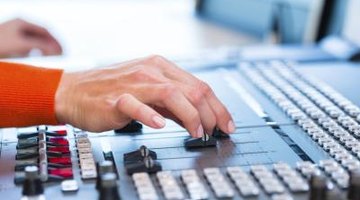Powered Mixer Vs. Unpowered Mixer
A mixer is used to control the level, timbre and dynamics of multiple audio tracks. Mixers are used by both live and studio musicians. One of the main decisions you have to make when selecting a mixer is whether to get a powered or unpowered model. Powered mixers incorporate a power amplifier into the mixer. Unpowered mixers require a separate amplifier.
Cost

Neither the powered nor the unpowered mixer has a clear benefit in terms of cost. Both variants can potentially be cheaper, depending on the situation. For the same quality of mixer, an unpowered mixer normally costs less. The powered mixer costs more because of the added cost of the installed power amp. The downside is that unpowered mixers require a separate amp. The cost of an unpowered mixer and a separate amp usually exceeds the cost of just a powered mixer. Powered mixers are more commonly aimed at musicians with smaller budgets, which results in there being many more powered mixer options in lower price ranges in comparison to the unpowered options.
Size
Mixer size is another conditional difference between the two types. Unpowered mixers are almost universally lighter than powered mixers. Powered mixers are often designed for live performers, where mobility is a more important issue. This results in many powered amp models being significantly smaller and less bulky, despite the extra weight. In some cases, the size difference is so significant that unpowered mixers end up weighing more than the powered mixers. The actual mixer components weigh less, but the added weight of the larger casing and controls can be significant.
Convenience
Powered mixers have a huge advantage over unpowered mixers in terms of convenience. Powered mixers typically require minimal setup time. All of the controls for the sound are located on the mixer board. Unpowered mixers require a power amp to be set up, in addition to the mixer itself. Some of the control functions may also be split between the mixer and the amp, which can make it less convenient to use. Powered mixers are generally more durable designs than their unpowered counterparts.
Quality
Higher-quality mixers are nearly universally built in unpowered variants. These are often targeted primarily toward studios rather than live musicians. The larger size is usually preferred for studio usage. Mobility is not an issue, since the mixer is not likely to ever be moved. Almost every studio also has multiple power amps or is capable of recording a nonamplified signal. This renders the built-in power amp in a powered mixer unnecessary.
References
Writer Bio
Matthew Anderson started as a writer and editor in 2003. He has written content used in a textbook published by Wiley Publishing, among other publications. Anderson majored in chemical engineering and has training in guitar performance, music theory and song composition.
Photo Credits
- kzenon/iStock/Getty Images
More Articles



